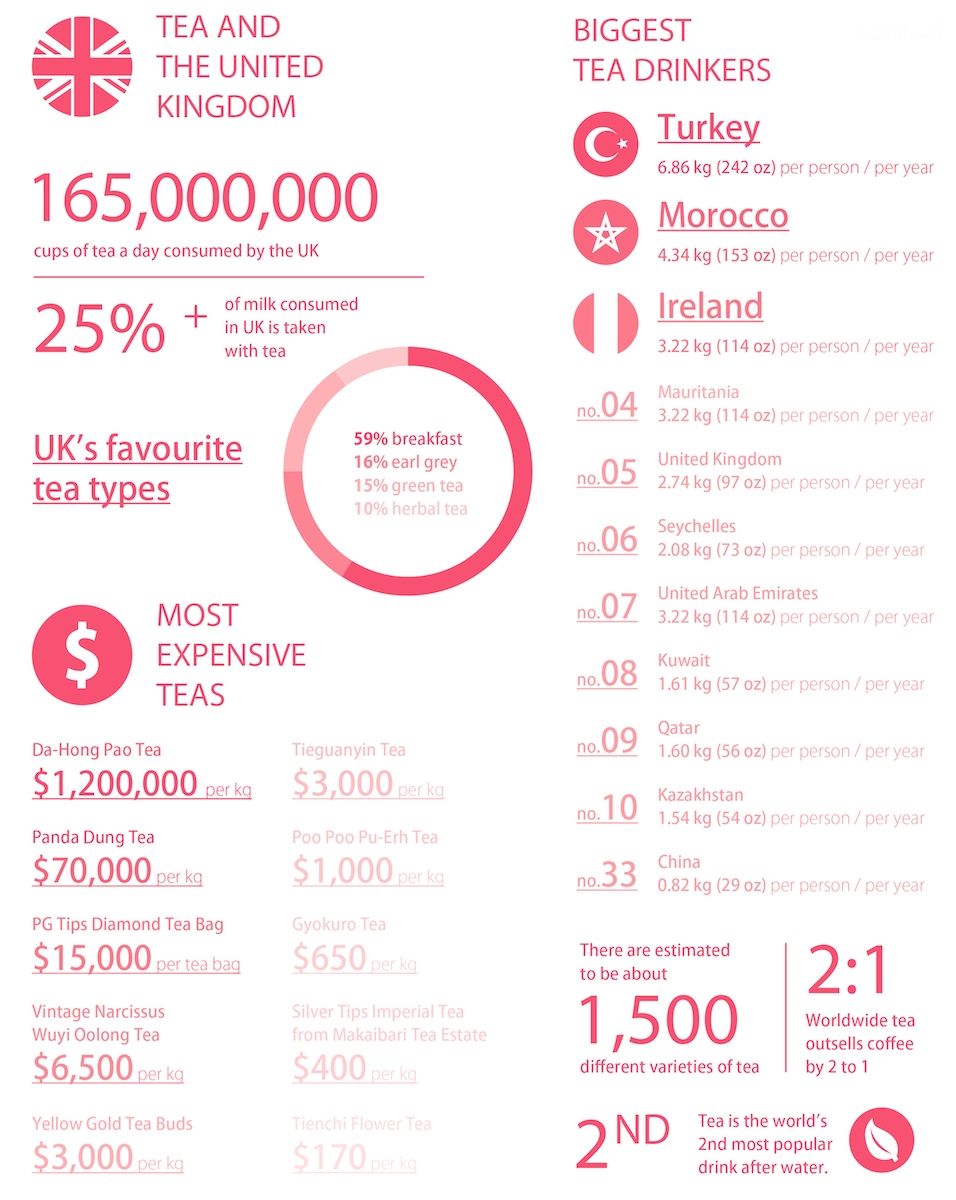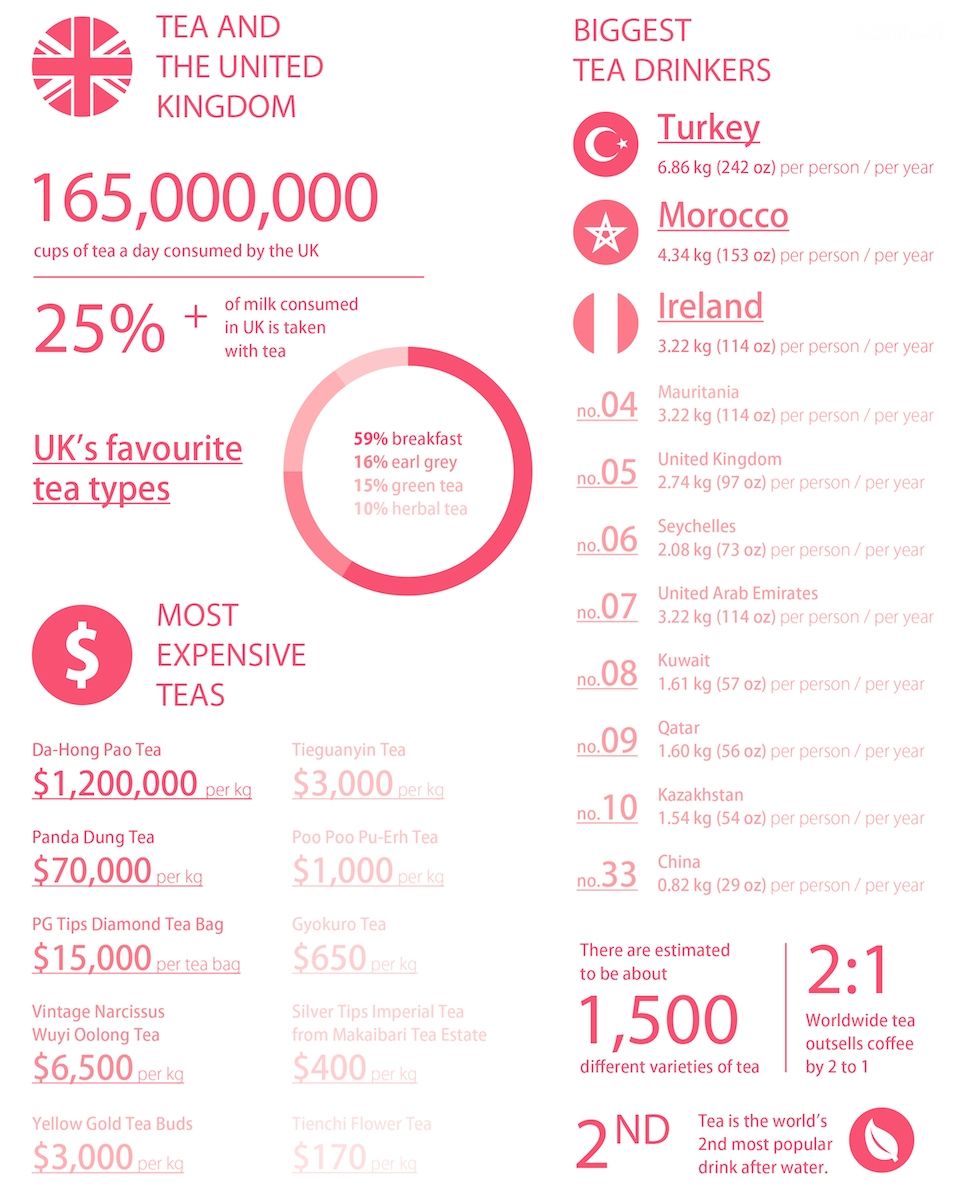
TEXT BY 撰文 X NICHOLAS ANDERSON尼古拉斯·安德森
TRANSLATE BY 翻譯 X SHORAN JIANG姜嘯然
From its discovery in China in 2737 BC to its enthusiastic welcome in London in 1644 AD, tea has become a worldwide phenomenon and beloved staple. Whether enjoyed in a picturesque Chinese courtyard garden or on a builder’s worksite, tea is instantly recognisable in any of its myriad forms or tastes and the love of it ties together both countries and social classes.
The tea plant (Camellia sinensis) is native to south eastern Asia but has since spread worldwide and is now seen by many as Britain’s cultural beverage and the land most famous for drinking it. Whether you recognise it as Tea, Chai or Cha, the word like the plant owes itself to China. Cha was originally a mandarin loan word which still in use today, whereas tea is believed to have come from an older version of the word passed through the southern Fujianese Amoy dialect to Dutch sailors who brought it, along with the product back to Europe.
Ranking 5th for tea consumption in the world with 2.74kg per person per year, the Britain now far exceeds China in 33rd place drinking 0.82kg per person per year. However both countries lag far behind Turkey with an astonishing 6.86kg per person. Whilst a definitive quantity per capita is hard to pin down amongst ever shifting tastes and preference, including the currently trendier coffee chains that fill every high street, the overall rankings are fairly consistent with a recent survey indicating that the average person in the UK drinks 17 cups a week!
A sense of ceremony With nearly five thousand years to practice, China has had the time to develop a refined taste and preference for drinking tea. Amongst the more formal and famous methods is the Gongfu tea ceremony where the water source and precise temperature are as critical to the brew tasting good and satisfying the soul as the leaves themselves.
When it comes to your water source, water from mountains or springs is best, river water is inferior and well water is simply a choice of last resort. In fact for consummate enjoyment you may require as many as 24 or so tools to do things right. Of paramount importance is an appropriate brewing vessel, a tea pick for clearing the teapot spout and a brewing tray or porcelain plate to hold spills. Some of the more optional equipment would include a calligraphy-style brush with a wooden handle, used to spread the wasted tea evenly over the tea tray to ensure no part dries out and the tea ‘stain’ is spread evenly to lend a pleasing colour to the tray.
Traditionally the temperature of the water was observed by close scrutiny and careful timing. In particular the size, appearance and sound of the forming air bubbles allowed the perfect amount of temperature to be applied as each strain required. In terms of keeping your eye on the temperature, the following guidance was given;
At 75 – 85°C, the bubbles formed are known as “crab eyes” and are about 3 mm in diameter. They are accompanied by loud, rapid sizzling sounds. At 90 – 95 °C, the bubbles, which are now around 8 mm in diameter and accompanied by less frequent sizzling sounds and a lower sizzling pitch, are dubbed “fish eyes”. When the water reaches boiling point, both the formation of air bubbles and the sizzling sound ceases.
In the case of the Gongfu ceremony, as much care and attention is given to each stage of the tea ceremony from warming the pots and heating the cups to respectfully receiving the fragrant tea as is given to the taste. The overall goal is for the tea’s quality, the drinkers’ moral quality and the surrounding environment to harmonise.
In its most well-known form, the British equivalent of a tea ceremony is High tea (properly known as afternoon tea or low tea in the Britain but High tea to the rest of the world), however the focus here is much more on the accompanying side dishes and social atmosphere, then purely on drinking the tea itself.
The invention of High tea in the form that it is now known is credited to Anna, the 7th Duchess of Bedford and her hunger during one late afternoon in the early 19th century. At that time it was traditional to only eat two meals in a day, one a late breakfast and the other a large dinner served after 8pm. To tide herself over, she would order tea, small sandwiches and cakes to be served in her room in the afternoon. Later on, this high tea progressed into a communal gathering whereby the Duchess would invite friends to join her at her home to drink, eat and converse. This light tea was such a success that the habit quickly caught on with the rest of high society.
The popularity of high tea and tea in general would take a little longer to reach the rest of the population as at this point in history tea was still such a rare and pricey commodity for people in Britain, in part due to the government’s import duties that reached as high as 119 percent, in part to support the maintenance of the British empire. In the well-off houses that could enjoy this luxury, tea would be kept in locked boxes or containers so that the servants wouldn’t steal it.
Raw materials While you may enjoy yours with a dash of milk and a couple of sugars, in the rarefied world of the tea connoisseur, things are often more measured. Something that all tea lovers can agree on, no matter if you take your tea straight, blended or mixed is that the leaves themselves are of supreme importance.
Under the western tea grading system quality is ascribed by measuring the quality and condition of the tea leaves themselves. At the top end of this scale for black tea is FTGFOP (Finest Tippy Golden Flowery Orange Pekoe, or sometimes jokingly translated as “Far Too Good for Ordinary People”).
Broken down this refers to a whole leaf tea (Orange Pekoe) picked from the newest shoots of the tea plant and consisting of two leaves and a bud picked early in the season resulting in slightly golden colouration. These shoots are picked only using the balls of the fingertips as fingernails or mechanical tools would cause unwanted bruising.
At the lower end of the scale you might describe other teas as broken leaf, these leaves produce a darker cup as they infuse faster than whole leaf teas. Fannings and dust are leaf particles too small to be classified as broken leaf, typically used in mass marketed tea bags. CTC or crush, tear and curl mechanically processed tea is used to create very strong flavoured, quick infusing tea.
China has a similar way of characterising the quality of the collected tea which peaked during the Song dynasty when a high quality tea could be priceless.
To collect tea of the highest quality tea, it was important that tea leaves should only be picked at the right time of the year, the best time identified as being between the Waking of Insects (early March) and Pure Brightness (early April) or just before the Qing Ming Festival. Furthermore the temperature and weather on the day of harvest were crucial. If the day was too sunny or the collecting basket has been left in the sun, the tea leaves would lose some of their moisture, this would impinge the taste and damage the essence. Therefore, it was best to pluck the tea early in the morning so that tea leaves would still have a little dew on them. However if it had been raining the quality would also have been adversely influenced and so tea was never picked during rainy days.
In China tea is picked with the nails instead of the fingers so that its quality is not affected the by the hand’s temperature or possibly contaminated with sweat. The tenderer the buds are, the better the quality will be. Time to drink In China, teacups are usually quite small holding no more than 30ml of liquid. Tea was intended to be enjoyed in three sips, one for flavour, the second for presence and the third for the aftertaste.
After tea’s import British people tended to drink much larger quantities in one sitting, whether by adding milk and sugar or just a slice of lemon, this required a much larger tea cup. Enjoying the beverage hot, British ladies had a hard time figuring out how to drink it hot, whilst maintaining a graceful air and not burning themselves. This lead to the creation of the teacup handle and teacup set.
In modern times, China has adapted to the need for tea on the go with the rising popularity for double walled glass infusing bottles which allow the tea to be kept hot and the hands cool whilst enabling you to admire the unfolding bud in a blooming tea.
自茶在公元前2737年被首次發現,至其於1644年在倫敦的大受歡迎,茶已然成為了風靡全球的珍甘以及深受愛戴的佳品。無論是在別緻如畫的中式庭院裡品飲,亦或是在建築工人的工地上享受,在其眾多的形質或口味中,茶一眼可辨,對於茶的喜愛更是聯結了不同國家和不同社會階層。
茶樹原生長於東南亞,後在世界範圍廣泛傳播,如今已被許多人視為英國的飲品,而英國亦因喝茶而最為著名。不論稱之為“Tea”、“Chai”還是“Cha”,這個詞,如同茶樹本身都是源自中國。 “Cha”這個詞起初是漢借詞,如今仍在中國使用,而“Tea”這個詞是源於一個更古老的譯本,它是隨著荷蘭水手們隨著貨物一起帶回歐洲的福建南部廈門的方言。
如今,英國的茶葉消費量為每人年均2.74公斤,排名世界第五,遠遠超過了排名世界第33位、每人年均茶葉消費量為0.82公斤的中國。然而,這兩個國家都遠遠落後於土耳其,土耳其年人均的消費量是6.86公斤。人們的口味和喜好持續變換,充斥於各個高街的時髦咖啡連鎖店亦然,雖然這些變化致使明確的人均消費數量很難確定,但是最近的一次問卷調查表明了英國人均飲茶数量高達每週17杯,這也與整體的年人均茶葉消費量排名一致。 儀式感有了近五千年的實踐,對於如何飲茶,中國已然發展出了一套雅緻的品味和喜好。其中最為正式最為著名的就是功夫茶道,釀造味美而慰心的好茶,水的來源與精確的溫度與茶葉本身同樣重要。
沖茶的用水,“山水上,江水中,井水下”。事實上,在古代,若想達到至臻的體驗享受,甚至需要約24件茶具。必不可少的茶具中包括了適宜的茶壺、用以清潔茶壺嘴的茶夾以及盛置的灑水茶盤或瓷碟。在可選的茶具中,有書法毛筆風格的木柄茶掃,用以將茶渣在茶盤上均勻地攤開,以確保沒有乾燥的茶渣,同時將茶漬均勻地塗在茶盤上以產生包漿的色澤(此法屬台灣用法)。
傳統上,水溫需要緊密觀測,時機也需拿捏得恰到好處。通過氣泡的特定大小、形狀以及形成氣泡的聲音可以掌控水溫,使每一泡茶盡善盡美。就肉眼觀測溫度而言,以下可指導一二: 75 – 85°C時,氣泡直徑約3毫米,形狀似“蟹眼”,伴有響亮、快速的噝噝聲。 90 – 95 °C時,氣泡直徑約8毫米,伴有頻繁的噝噝聲,謂之“魚眼”。 當水達到沸點的時候,所有氣泡和響聲都停止了。
在功夫茶道中,從淋罐燙杯到嗅杯品茶,茶道的每一個階段都至關重要。所追求的是茶的品質、飲者的雅趣與周圍的環境氣氛的和諧統一。
眾所周知,等同於功夫茶的英國“茶道”當屬正式茶點(High tea),在英國被稱為下午茶(Afternoon tea)或者晚餐前茶(Low tea),而在其他地方被稱為正式茶點。然而,在英式下午茶裡更關注的是隨茶的佐餐以及社交氛圍,而後才是喝茶的本身。
正式茶點的發明應該歸功於十九世紀初期的貝德福德公爵夫人七世安娜女士以及她那顆在下午就會餓的胃。那個時候的傳統是一天兩餐,即一頓很晚的早餐和晚上八點以後的大餐。為了安然度過兩餐的間隔,下午的時候,她會點一些茶、小三明治和蛋糕在房間裡享用。後來,這種正式茶點發展成為了一種聚會,公爵夫人會邀請她的朋友來到她家與她一起飲茶、品嚐餐點和交談。這種簡餐淡茶的習慣大獲成功,很快就在上層社會流行開來。
在那個時候,正式茶點和茶的流行尚需要時日,因為當時對於英國的普羅大眾來說,茶仍然是稀有且貴重的商品,其中一部分原因是當時政府徵收的高達119%的進口關稅,某種程度上用以維持大英帝國的運轉。在那些可以享受這種奢華的朱樓翠閣中,亦會將茶葉鎖之高閣,以防僕人偷盜。 原材料
在享用茶的時候,你也許會加一些奶和幾塊糖,而在鑑賞家的深奧世界裡,這些甚至是要銖稱寸量。但是所有的茶愛好者都會認同的是,不論你是單飲茶,或是品飲混配的茶,或是加入了其他原料的茶,茶葉本身的地位始終都是至高無上的。
在西方茶葉評級體系中,茶葉是通過測量茶葉本身的品質和狀態來決定的。這個體系中的頂級紅茶是FTGFOP,即頂級毛尖花橙白毫(Finest Tippy Golden Flowery Orange Pekoe),有時候這個縮寫也被戲謔為“太過優良,不適合普通人”(Far Too Good for Ordinary People)。
所謂頂級毛尖花橙白毫指的是從最鮮嫩的茶樹芽上採摘的一整片茶葉(橙白毫),由兩片茶葉和一個嫩芽組成,嫩芽是在採茶季早期採摘的,所以嫩芽稍顯金色。這些嫩芽只可以用指肚採摘,因為指甲或機械工具會對嫩芽造成不必要的傷害。
評級系統里低一級别的茶葉是碎葉,沏泡碎葉得到的是色澤較深的茶水,較之於整葉,碎葉可以被更快地泡開。茶末和茶塵是那些太小的碎葉,小到已經不能歸類為碎茶,這些通常用於製作量產的茶葉袋。CTC(crush, tear and curl)即器械加工的“擠壓撕裂捲曲”的茶葉是用來製作口味濃重,快速沖泡的茶。
中國有一套相似的茶葉品评標準,在宋朝達到巔峰,那時候的极品茶葉甚至價值連城。
要得到最高品質的茶葉,采摘时间尤為重要,需要在每年特定的時節採摘。茶葉最好的採摘時節便是三月初的驚蟄以及四月初的清明或者是清明節前夕。此外,溫度和收穫當日的天氣也極為關鍵。如果採摘當日艷陽高照或者籃中的茶葉在陽光下太久,茶葉便會丟失水分,這樣會影響其味而損其精髓。因此,最好的時間是在清晨摘茶,這樣就可以留下些許露水在茶葉上。然而,雨水同樣會對品質產生負面影響,所以採茶不會在下雨天進行。
在中國,茶葉由指甲掐下,而非指肚捏取,因為這樣茶葉的品質不會受到手溫的影響和汗水的污染。茶葉頂端的嫩芽越嫩,茶的品質則越好。 品飲在中國,茶杯通常都很小,其容积一般不超過30毫升。品茶分三步,一觀其色,二聞其香,三品其味。
隨著茶葉的進口,英國人更傾向於可以一次喝更多的茶,不論是加奶還是加糖,或是一片檸檬,這都需要一個更大的茶杯。為了享用熱茶,英國女子們曾經有一段尷尬時期,來解決喝到熱茶的同時如何可以保持優雅的姿勢,又不會燙傷自己。這就導致了茶杯把手和成套茶杯的產生。
現代,生活忙碌却需要飲茶,在中國便出現了雙層玻璃瓶,這樣茶水既可以保溫也不會燙手,亦可以將開花茶的含苞綻放盡收眼底。


